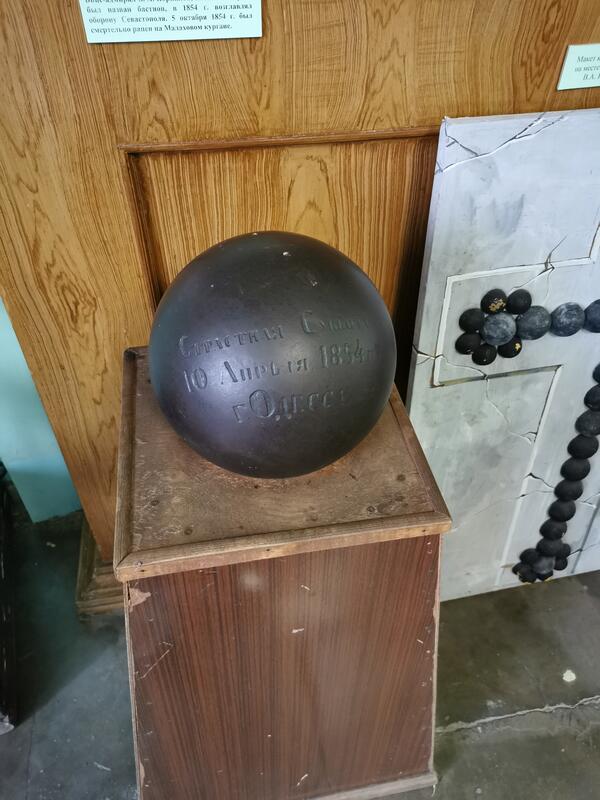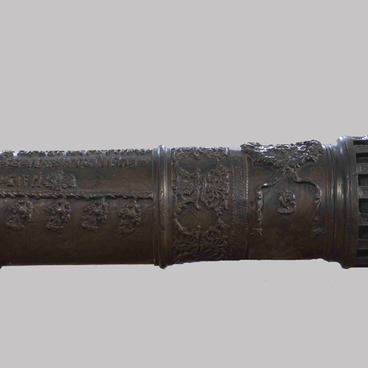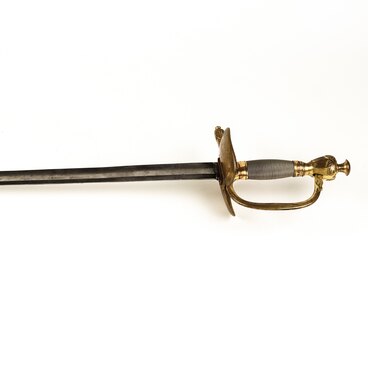Stone cannonballs, and later cast iron ones, were the main artillery shells before rifling was introduced. In the second quarter of the 19th century, large-caliber bomb cannons appeared in France. They fired explosive projectiles. Soon such guns were used by the fleets of England, the North American United States and Russia.
This cannonball was fired from a British 10-inch cannon during the shelling of Odessa on April 10, 1854.
To defend the city, six coastal batteries were deployed and positioned on the moles. The 6th left flank battery, commanded by ensign Alexander Petrovich Shchegolev, seemed to be the most vulnerable: the Military Mole with the Prakticheskaya Harbor protrudes into the sea.
Apart from the commander, the battery crew consisted of 32 people, including bombardiers and volunteers. They had four 24-pounder guns at their disposal, which were cast in 1723. They were dug out of the ground and cleaned of rust only one day before the attack (previously they were used as posts for tying up small ships).
28 enemy ships began shelling the city early in the morning and destroyed five of the six defense batteries by noon.
Nine ships concentrated fire on Shchegolev’s battery. Two of the four guns were destroyed, and by the end of the day only one remained. Despite this, the battery held back the fire of more than 350 guns for six hours and destroyed three enemy ships: the English, Austrian and Dutch ones. Having run out of ammunition, Shchegolev’s soldiers were leaving in pairs in full view of the enemy. Thus, the landing operation was disrupted, and the enemy squadron left for Sevastopol.
Newspapers of that time noted that the shelling caused minimal damage to the city: there were no fires or destroyed buildings. The defense batteries prevented the enemy flotilla from reaching a distance which would be dangerous to the city.
For this feat, the lower ranks and volunteers were awarded the Insignia of the Military Order, and all participants received an additional annual salary.
In one day, by decree of Nicholas I, Shchegolev received the rank of staff captain. He was awarded the Order of St. George, 4th class, as well as a letter of gratitude and an honorary sword with an inscription in gold letters on both sides, “To the Brave Defender of Battery No. 6” and “Odessa, April 10, 1854” from Grand Duke Mikhail Nikolaevich. Grand Dukes Alexander, Nicholas and Vladimir Alexandrovich sent him silver epaulettes and the personal cross of Tsarevich Alexander, which he had received for “dealing” with the highlanders in 1850. Shchegolev’s name was included on a marble plaque of the Noble Regiment. His lithographed portraits were sent to all military educational institutions of Russia.
The destroyed battery was restored and renamed as Shchegolev’s battery.
This cannonball was fired from a British 10-inch cannon during the shelling of Odessa on April 10, 1854.
To defend the city, six coastal batteries were deployed and positioned on the moles. The 6th left flank battery, commanded by ensign Alexander Petrovich Shchegolev, seemed to be the most vulnerable: the Military Mole with the Prakticheskaya Harbor protrudes into the sea.
Apart from the commander, the battery crew consisted of 32 people, including bombardiers and volunteers. They had four 24-pounder guns at their disposal, which were cast in 1723. They were dug out of the ground and cleaned of rust only one day before the attack (previously they were used as posts for tying up small ships).
28 enemy ships began shelling the city early in the morning and destroyed five of the six defense batteries by noon.
Nine ships concentrated fire on Shchegolev’s battery. Two of the four guns were destroyed, and by the end of the day only one remained. Despite this, the battery held back the fire of more than 350 guns for six hours and destroyed three enemy ships: the English, Austrian and Dutch ones. Having run out of ammunition, Shchegolev’s soldiers were leaving in pairs in full view of the enemy. Thus, the landing operation was disrupted, and the enemy squadron left for Sevastopol.
Newspapers of that time noted that the shelling caused minimal damage to the city: there were no fires or destroyed buildings. The defense batteries prevented the enemy flotilla from reaching a distance which would be dangerous to the city.
For this feat, the lower ranks and volunteers were awarded the Insignia of the Military Order, and all participants received an additional annual salary.
In one day, by decree of Nicholas I, Shchegolev received the rank of staff captain. He was awarded the Order of St. George, 4th class, as well as a letter of gratitude and an honorary sword with an inscription in gold letters on both sides, “To the Brave Defender of Battery No. 6” and “Odessa, April 10, 1854” from Grand Duke Mikhail Nikolaevich. Grand Dukes Alexander, Nicholas and Vladimir Alexandrovich sent him silver epaulettes and the personal cross of Tsarevich Alexander, which he had received for “dealing” with the highlanders in 1850. Shchegolev’s name was included on a marble plaque of the Noble Regiment. His lithographed portraits were sent to all military educational institutions of Russia.
The destroyed battery was restored and renamed as Shchegolev’s battery.



